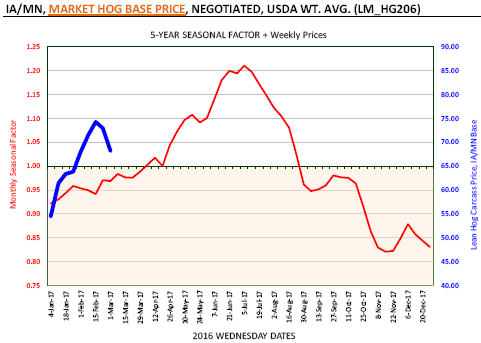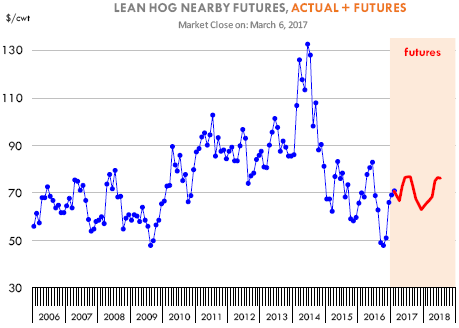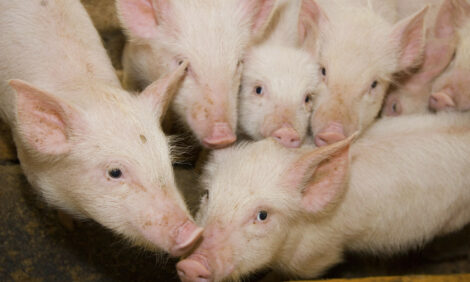



CME: Lean Hog Prices Up Faster Than Usual
US - Lean hog prices rose at a faster than normal pace in late January and February due to a short-term squeeze in the spot belly market, excellent demand in both domes, according to the Steiner Consulting Group, DLR Division, Inc.In recent days, however, prices have adjusted lower as some of the factors fueling the rally appear to be losing steam. Pork belly prices, which approached all-time record highs at an unusual time of the year, have declined sharply.
USDA quoted the pork belly primal value on Friday at $137.86/cwt, $24/cwt (15 per cent) lower than a week ago and $45/cwt (25 per cent) lower from the peak on 9 February. The decline in the belly primal value has removed about $7/cwt from the value of the pork cutout since the February peak and packer margins today are a lot smaller than they were a few weeks ago.

The guessing game at this point is what the outlook will be for belly prices going into the spring and summer months. Did the dramatic surge in prices recently permanently impact the ability of retailers to promote bellies into the spring? It’s a tough question to answer but judging from the recent moves in futures we would think the answer is “maybe a little.”
After all, if retailers are to run belly ads into Memorial Day, they need to get some of the deals in place shortly so that processors can start building inventory in April. Even with the recent price pullback, prices are still quite a bit higher than they were last fall.
Processors will likely be quite conservative in the prices they offer for the spring given the volatility and the reality of still very tight belly inventories. Some market participants still remember the spring of 2015, when bellies traded in the low 60s following the sharp run-up in price during the PED crisis the previous year.
But it is important to remember that none of this tells us much about bacon demand or consumer preferences. Consumers like bacon as much today as they did yesterday or last year. What we observed in the last few weeks was a classic short covering rally and the half life of such rallies tends to be quite brief.
On the supply front, hog number appear to be in good shape and slaughter last week was close to the levels indicated by the Hogs and Pigs report. Total commercial hog slaughter for the week ending 4 March was 2.311 million head, 3.9 per cent higher than a year ago. Hog slaughter this week should remain above 2.3 million head and average about 2.285 million head for all of March.
Even as hog prices adjust lower and are now a bit more in line with what we should expect based on seasonal trends, there are still a number of positives in the current hog/pork market. For one, we are still seeing very strong demand for pork as US prices are more competitive relative to what European and South American producers can offer in the world market.
We think that over 22 per cent of the pork produced in the first two months of the year went to export destinations (see our discussion of exports two days ago). With pork supplies expected to remain well above year ago levels for the reminder of 2017, it is critical that pork trade continues uninterrupted.

Clearly futures markets so far have discounted the risk of any such disruptions. One need only look at where futures currently are pricing hogs for the second half of the year, with the summer/fall discount being much smaller than in the last two years. Some of this is due to the expected impact of new plants coming online, which should bolster demand for hogs.
But it also reflects expectations that pork exports will remain quite robust. Fall and winter hog prices would be quite vulnerable to the downside in the event of disruptions to our current pork export situation.
.gif)








